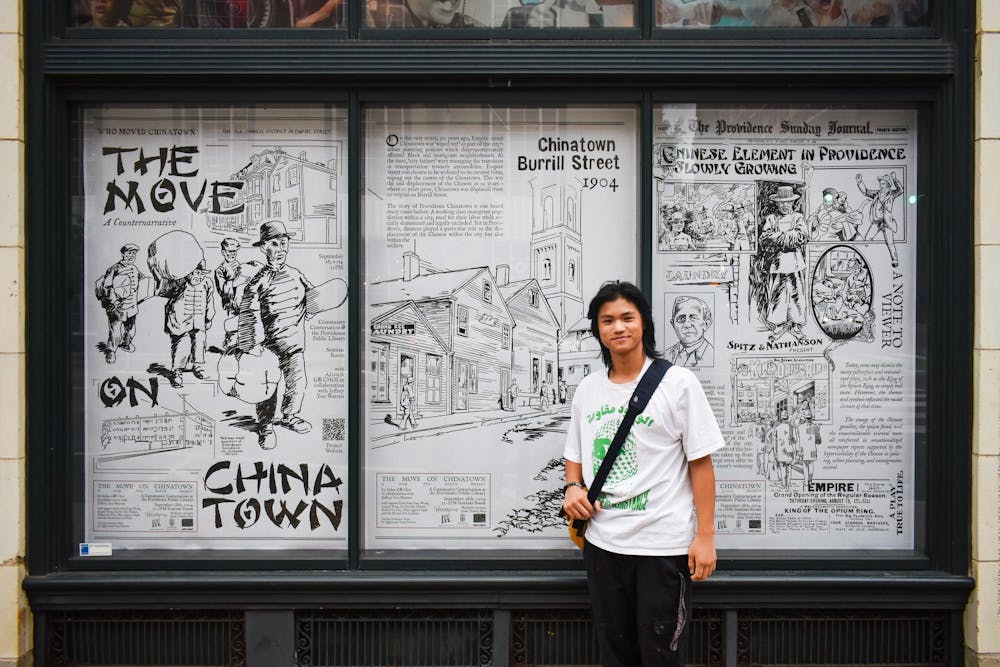On Sep. 20, three panels went up on the windows of Trinity Repertory Company on Empire Street, which just over a century earlier ran through the heart of Providence’s Chinatown. The display, a collection of historical drawings and texts related to the historic neighborhood, is a visual portion of “The Move on Chinatown,” a project curated by literary and visual arts creative Aidan Choi ’26.

The project focuses on the “move” that occurred in Chinatown in 1914 and the ways in which displacement affects communities, Choi told The Herald. “I want folks to think critically about the neighborhoods that they’re from: why did they live there before? What happened to them?”
“What communities are you impacting with your presence here? That’s a question that Brown, itself, can reckon with,” he added.
Choi first interacted with the history of Providence’s Chinatown during his freshman year, when he visited an exhibit titled “Seeing Providence Chinatown” with a class. At that exhibit, Choi met his soon-to-be mentor Jeffrey Yoo Warren, a 2023 Library of Congress Innovator in Residence who served as his advisor on the project.
Back then, “I didn’t know there was a Providence Chinatown,” Choi said.
Choi submitted his project idea to be represented in the Brown Arts Institute’s inaugural IGNITE Series. Thea Quiray Tagle, a scholar of Asian American and visual studies and an associate curator for Brown Arts Institute and the David Winton Bell Gallery, was an advisor for Choi’s project.
According to Quiray Tagle, Choi was the only undergraduate student to receive an IGNITE grant among a “competitive” pool of students, faculty and community member applicants. The “strength of his project and how dynamic it was,” in addition to “a deep community-engaged component,” led to his reception of the grant, Quiray Tagle said.
After meeting Yoo Warren, Choi asked to be a part of his community project that used archival images to virtually reconstruct Chinatown.
“He allowed me to look through his newspaper research,” Choi said. “I came into this with already a legacy and foundations of work” by Yoo Warren and others.
Going through “1,500 newspaper articles, census records (and) business directories,” the Empire Theatre’s productions stood out to Choi. The theater was built to “raise the property value of the neighborhood — to drive the Chinese out,” he said. “The opening play of their regular season was the ‘King of the Opium Ring.’ It fed every single anxiety of the time.”
In Choi’s window display, a historical advertisement in the far-right corner lists the acts and features of that performance, all of which reinforced harmful stereotypes.

On Dec. 13, 1914, the Providence Sunday Journal released an article titled “Chinatown on the Move.” Drawings of it have been repurposed on Choi’s display to reveal the true nature of this “move.”
“Who did? What did? What happened? The Chinese would not have just moved themselves, and if they did, why wasn’t it recorded?” Choi said.
The rearrangement of people — the “move” from Chinatown — displaced other residents of Providence, and it is this community-damaging nature that Choi emphasizes throughout his project and study.
“Displacement never happens in isolation,” he said.
“This project actually is doing the work of creating a different kind of community, even before it’s seen by the public,” Quiray Tagle told The Herald. It “is about community, talking about the erasure of historic Chinatown even from memory as well as from an actual place.”

Choi’s project will culminate in a community conversation and celebration on Sep. 28 at the Providence Public Library, featuring a discussion with artists, scholars and community members, as well as additional displays and an educational zine created by Choi.





